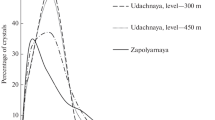3. Summary
Approximately ten per cent. of the total number of diamonds form group A and another ten per cent. group B. These two groups exhibit highly contrasting characters. Group A diamonds are isotropic and optically perfect, are opaque to ultra-violet of wavelengths less than 0·3µ and exhibit a visible blue luminescence. Group B diamonds are visibly birefringent, their transparency extends well beyond 0·3µ and they are non-luminescent. The two groups differ strikingly in their infra-red behaviour. These facts taken in conjunction indicate that the two groups of diamond differ fundamentally in their crystal structure.
Similar content being viewed by others
Additional information
Memoir No. 129of the Raman Research Institute, Bangalore-6
Rights and permissions
About this article
Cite this article
Raman, C.V. The infra-red absorption by diamond and its significance. Proc. Indian Acad. Sci. 55, 5–9 (1962). https://doi.org/10.1007/BF03045800
Received:
Issue Date:
DOI: https://doi.org/10.1007/BF03045800




